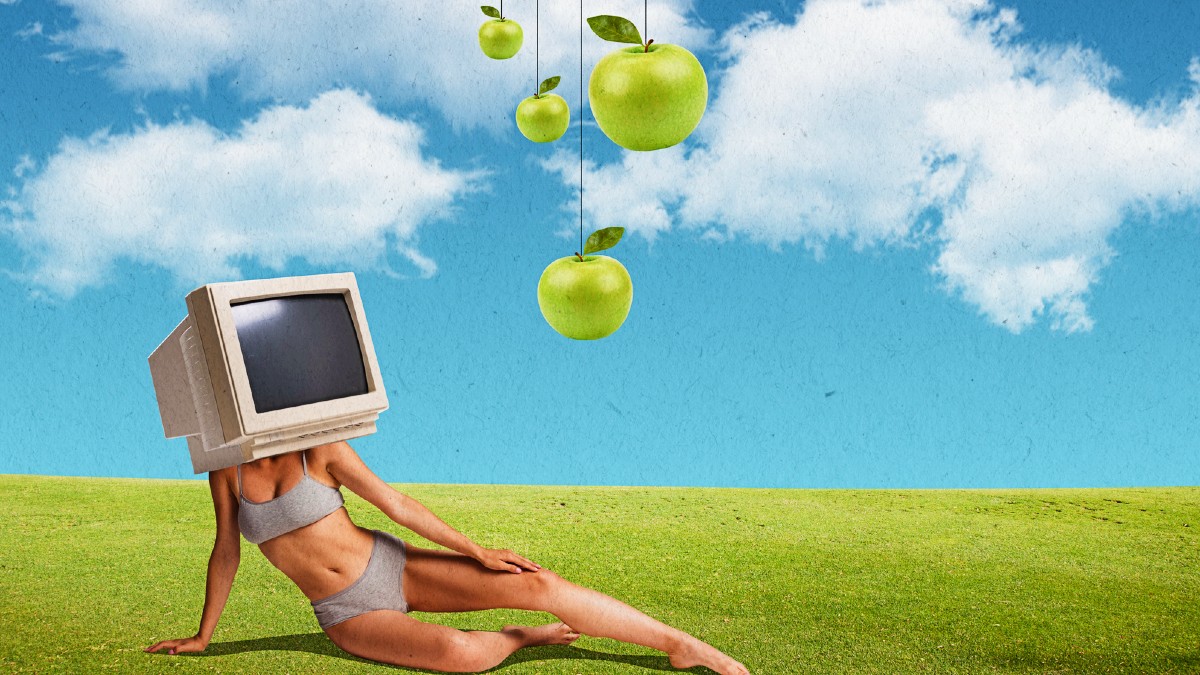Hold the phone: Apple’s annual product launch has lost some shine

Via Getty
Shares in Apple (AAPL) fell fallen 3% in two sessions following the much-hyped (as ever) release of the 15th iteration of various iThings.
Apple recently made history as the world’s first $3 trillion company, making it the biggest company in the world by market cap, thanks to its endless expansion and reinvention into new markets amid signs of improving inflation.
But a chorus of analysts are betraying an unfamiliar indifference to the annual reveal and associated marketing boost.
I myself have analysed the yearly pre-recorded ritualistic video of senior Apple execs fabulating to emotional musak (below) and I’ve come away slightly nauseated by the sickly sweet coo of self-adulation about nothing.
Needham analysts called the event “very sleep-able through. Nothing’s new. Nothing’s exciting.” Adding that Apple “put a lot of money into the brand of Apple… because the product iterations were very mediocre.”
A whole panopoly of new-but-old toys including the new iPhone 15 series were waved about, but if it’s getting harder to wow me after 15 iterations, then good luck moving the dial with the kids in the age of AI.
Still.
Here’s the 90 minute launch. Unless you’ve been inoculated to corporate digital self-congrats, well, I dare you… It’s been viewed 27 million times, so people are getting through it.
Still the biggest fruit in the bowl
According to all measures, APPL is still the biggest in the world by a long, long way – and even with Chinese officials swallowing a ban on iPhone products, there doesn’t look to be any insurgent company threatening Apple’s lofty spot on the tree.
Shares closed down for Apple today, -1.7%, and are yet to recover to near-term highs early this month, prior to the ban out of China.
Apple is trading +35% year to date, but only +10.5% over the last full year.
Even ahead of the Big Day, JP Morgan came out early to give the tree a shake. They didn’t have to, and wouldn’t have timed it like that if they didn’t think APPL needed it.
They could see US investors were losing the easy confidence usually associated with an Apple product new product gala.
The bank did reiterate its Overweight rating, bur made a symbolic if not material cut to the price target by US$5 from US$235 to US$230.
The firm’s new forecast still suggests nearly 30% upside from Thursday’s close.
“We believe share price outperformance in the remainder of the year (particularly after a strong outperformance in 1H and underperformance between July and September) is dependent on beating what are now low investor expectations for the iPhone 15 launch,” JP Morgan suggested on Friday last.
Apple shares fell on the Wednesday before that, after rumours that the Chinese government planned to ban the use of iPhones across any and all state-aligned organisations, public and private.
But on Wednesday night, the Chinese Foreign Ministry half-heartedly shot down the Bloomberg and Reuters reports of government staffers given a directive to not use iPhones at work.
“China has not issued any laws, regulations or policy documents prohibiting the purchase and use of mobile phones from foreign brands such as Apple,” a Ministry of Foreign Affairs spokesperson said at the usual foreign press dance in Beijing.
That’s not a denial. Party bosses know how to read the China vs The Rest tech war tea leaves.
Beijing and Apple go way back, to be sure, but the marriage’s convenience may’ve run its course.
China is one of the company’s largest markets as well as its main manufacturer, and Apple has done plenty to placate the CCP, including handing over data on Chinese customers.
China’s president Xi Jinping has been spearheading an official push to secure new flows of foreign direct investment (FDI), but that won’t apply to a brand like Apple, so representative of US tech interests.
Same goes for Apple. China’s been good, but its importance has been offset by its risks.
Which is why the Cupertino-based US$3.03 trillion company began iPhone 15 production in Tamil Nadu, at supplier Foxconn Technology Group’s Indian facility.
Prime Minister Narendra Modi, fresh from hosting the China-less G20, has been laying out financial incentives to attract his own attention and investment into Indian manufacturing and that suits Apple’s need to cut off China amid the growing US-China trade blue and add some diversification to its supply lines.
But first: Wow us with the new tech
Can’t do. Not a lot.
There’s some changes. A few colours, a touch of titanium, another infuriatingly new cable and this time the toys will cost more.
But an ever optimistic Apple says it will accept orders for the new iPhone models starting on Friday, while the new models (no #15) will hit the shelves (officially) on September 22.
iPhone school
I don’t particularly like iPhones. But I’m obviously less of a conformist than ye of the compliant majority. Now, that said, I know heaps. Like, why have one model, when you can have lots – or, as of this morning, there’s four new models for your consideration:
-
iPhone 15: Bread and butter version, prices start at US$799 in the US, the same as last year’s model
-
iPhone 15 Plus: Hi-fibre bread and peanut butter. Got a bigger-screen-than-the-one-above. US$899 and up.
-
iPhone 15 Pro: Bread and 100’s&1000’s. This one’s got ‘high-end’ features and is generally fancier to look at. US$999 and up. Same-same price as last year.
-
iPhone 15 Pro Max: Hi-fibre peanut butter with 100’s&1000’s version. Pretty much same features as the Pro, but with a larger screen and Apple’s most smartypants camera features. US$1,199 and up in the US — which is US$100 more than last year’s comparable model.
Some more forgettable new Apple products
Apple Watch
Hard to tell if there’s any actual changes. Apple says it’s got a zippy new chip, which apparently makes the new Apple Watch feel… “zippier.”
I don’t wish to editorialise, but I will. In the end, it’s still a watch. So… unlikely anything about it is zippier.
Actually, the biggest change could be just double-tapping on the watch hand which now lets you control on-screen functions.
AirPod things
Hold the phone, Apple is changing the charging cable for the AirPods Pro, the wireless ear buds with a noise-canceling feature. That’s the only update worth noting.
A different charger
Mostly because those creepy European lefties made some laws forcing Apple to change.
From now Apple will ditch the cable used in iPhones since 2012 for the more common charging technology, USB-C.
Yup, this means when/if you buy a new iPhone, you might need to replace your existing iPhone charging plugs and maybe your iPods, too.
Hey. Now it’s got a new EU-imposed universal charge, owners of the new products you can use the same plug as billions of other phones, laptops and tablets that already use USB-C cables.
Imagine. You’ll be packing for Christmas hols and only need to dig up a single charger to power up everyone’s various gadgets. That’d be weird.
Fancy iPhone costs more
Continuing Apple’s recent pattern, the company put more exclusive features in Pro and Pro Max models — but for the first time in years, Apple is raising the prices for one of those two models.
Last year’s iPhone Pro Max cost $1,099 and up in the US.
The starting price on the new iPhone 15 Pro Max is $1,199.
But Apple says this price increase is not a price increase.
You see the new Pro Max has more data storage capacity than the old Pro Max. So NOT a price increase!
Buy the phone, fill the coffers
Globally and in Apple’s two most important markets of the United States and China, sales of new smartphones have been falling.
Apple’s revenue has been shrinking this year, too.
The company wants you to fill a hole in its bank vaults by making more money from each new iPhone.
New models improve incrementally these days, but Apple hasn’t changed its approach to reflect this new reality.
Every September like clockwork, the company makes a big to-do from new models of iPhones that get less dramatically different each year.
Why? Because Apple can.
Enough people are curious enough about this particular consumer product that Apple can get attention for its updated models. It’s essentially free publicity, including from writers like me.
Great, but not that great
JP Morgan says looking for upside in APPL shares heading into Christmas is limited by Apple’s year-to-date outperformance and an earnings multiple that is still unbothered at amore than 60% premium to the 2H 2019.
2019 is a handy example of when Apple’s shares outperformed simply by meeting or beating low investor expectations – in that case for the iPhone 11.
According to JP Morgan, investors should expect that given that the iPhone 15 does not include material upgrades, the average consumer will largely be driven by the desire to replace and/or upgrade their current models.
A price increase across all iPhones, instead of only the Pro models, will incentivise consumers to choose the higher-end devices, he added.
UBS doesn’t agree: They just say the iPhone 15 underwhelms.
-
Apple introduced its latest iPhones overnight, unveiling four new models.
-
Like last year, the entry-level model starts at US$799, the Pro Version remains at US$999. The Pro Max Average Selling Price (ASP) has been increased $100 to $1,199.
-
In an effort to coax consumers to upgrade, the higher-priced phones will have a faster A17 chip built on a 3-nanometer process and come with additional memory.
-
Arguably, consumers won’t noticeably notice a difference aside from battery life savings. The top model will also receive some camera enhancements (3x magnification to 6x)
-
The entry-level models are getting a camera upgrade, moving from a 12-megapixel main camera sensor to a 48-megapixel version. This means that the base model will now match the resolution of the main camera on last year’s iPhone 14 Pro.
-
The Apple Watch has a limited set of upgrades, focused on performance and new colours.
Consensus Recommendation: Buy / Price Target US$204.55 (Share Price US$176.30; -1.7%)
UNLOCK INSIGHTS
Discover the untold stories of emerging ASX stocks.
Daily news and expert analysis, it's free to subscribe.
By proceeding, you confirm you understand that we handle personal information in accordance with our Privacy Policy.








